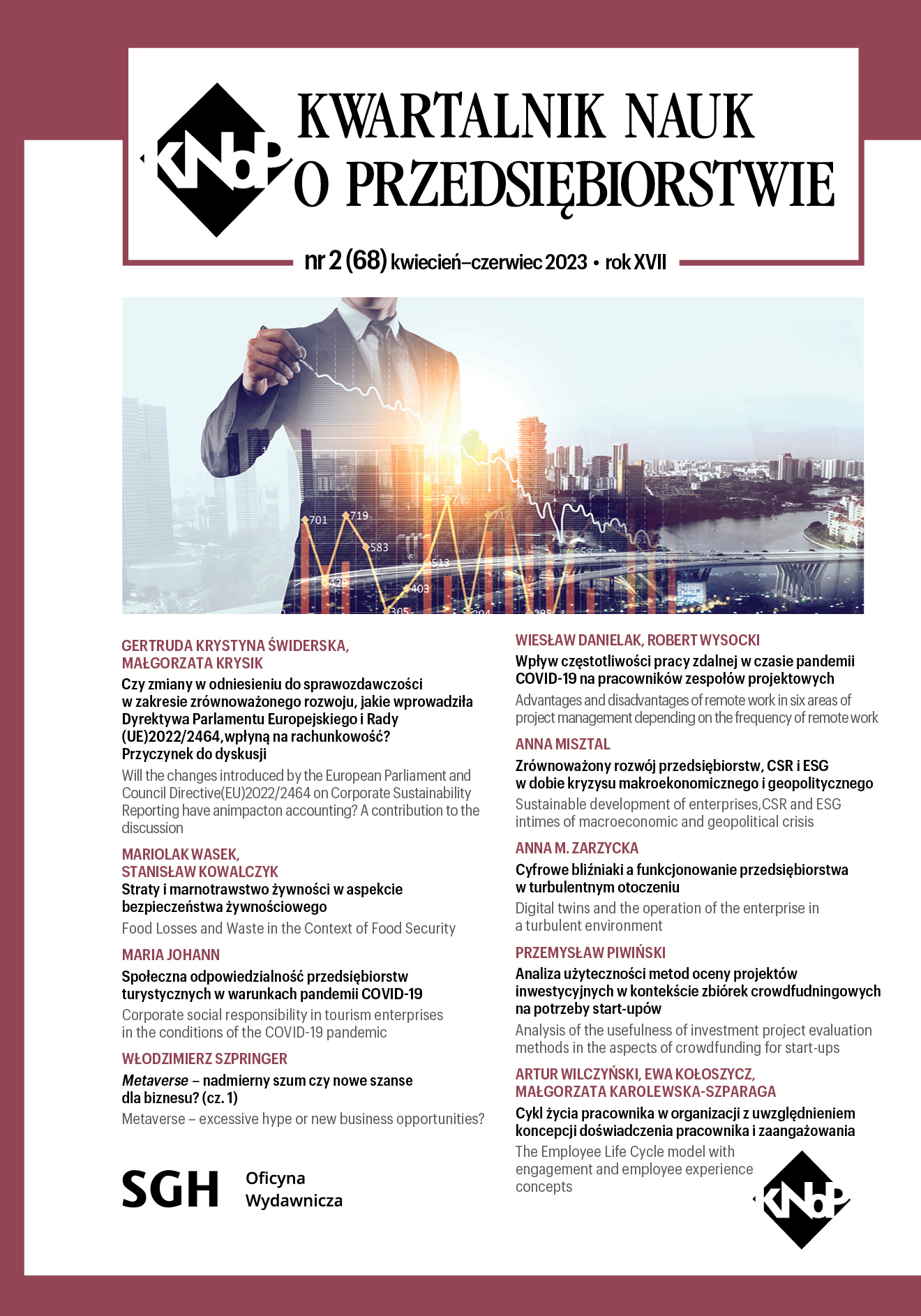Analysis of the usefulness of investment project evaluation methods in the aspects of crowdfunding for start-ups
Abstract
Start-ups are now an integral part of modern economies and are shaping a new reality for traditional business models. Technology start-ups are currently contributing to driving the global economy and entrepreneurship. Despite their flexibility and relatively low market entry costs, one of the main challenges facing the development of start-ups is the issue of financing. Start-ups do not fit into the traditional conventions of corporate financing. This is mainly due to the fact that they are relatively uncertain about their future. There is also a large asymmetry of information between the funder and the funded, resulting from the inability to check the effects of similar entities’ market activity. Out of the modern forms of business financing, such as business angel networks, crowdfunding, or initial coin offerings (ICO), crowdfunding fits very well with the concept of start-ups. Crowdfunding is based on internet platforms and serves as a meeting place for funders and funded. Essentially, crowdfunding is divided into four categories: donation-based, reward-based, peer-to-peer lending, and equity-based. In addition, crowdfunding platforms is as a kind of place where start-up investment projects have a chance to test their idea and promote it. The essence of the article was a discussion on whether and how startup creators conduct an investment profitability assessment of their projects when raising funds on crowdfunding platforms and whether they can identify and assess what factors contribute to the success of their project in the context of crowdfunding campaigns. For this purpose, a survey was conducted using the CATI survey technique among one hundred start-up creators and founders with experience in fundraising on crowdfunding platforms. The study examined the use of methods for evaluating the investment profitability of projects in crowdfunding campaigns by start-ups. In addition, the study also identified success factors that influence the success of a crowdfunding campaign. This is important because not all crowdfunding campaigns on platforms end successfully, and success factors are numerous and can be interrelated. According to the survey respondents, the most significant success factors for crowdfunding campaigns are the presentation of an investment profitability assessment of the project and the idea itself. This means that potential investors pay attention to the economic profitability of the project and are guided by investment pragmatism when selecting start-ups on crowdfunding platforms.
Full text article
References
Bernstein S., Korteweg A., Laws, K. (2017), Attracting Early-Stage Investors: Evidence from a Randomized Field Experiment. Journal of Finance. 72 (2), 509–538.
Brem A., Chang M., Cheng C., Kraus S., Richter C. (2016), Strategies for reward-based crowdfunding campaigns, Journal of Innovation & Knowledge, vol. 1: 13–23.
Covin J., Crescenzo V., Riberio-Soriano D. (2020), Exploring the viability of equity crowdfunding as a fundraising instrument: A configurational analysis of contingency factors that lead to crowdfunding success and failure, Journal of Business Research, vol. 115: 348–356.
Emiteo (2022), Baza danych polskiego crowdfundingu inwestycyjnego. https://emiteo.pl/equitycrowdfunding (dostęp: 04.08.2022).
Features, Technological Forecasting and Social Change, vol. 14, 128–137
Investigating crowdfunding success as a signal for enhancing trust in sustainable product
Klein M., Neitzert F., Hartmann-Wendels T., Kraus S. (2019), Start-Up Financing in the Digital Age – A Systematic Review and Comparison of New Forms of Financing, The Journal of Enterpreneurial Finance, vol 21, 46–98.
Lam W., Harris P., Zhao Y., (2019) Crowdfunding industry – History, development, policies, and potential issues, Business Research Institute, Vol. 19.
Light A., Miskelly C. (2015) Sharing Economy vs Sharing Cultures? Designing for social, economic and environmental good, Interaction Design and Architecture(s) Journal – IxD&A, N.24, s. 49–62.
Łukasiewicz A., Nadolska A. (2021), Poland: Country Report on the Sharing Economy. In The Collaborative Economy in Action: European Perspectives, University of Limerick, vol. 2, 236–248.
Mason C. M., Stark M., (2004) What Do Investors Look for in a Business Plan?, „International Small Business Journal”, vol. 22, s. 227.
Nielsen K. R. (2018), Crowdfunding through a partial organization lens: The co-dependent
Nofsinger J. R., Wang, W. (2011), Determinants of start-up firm external financing Organization, European Management Journal, 36 (6), 695–707.
Paschen J., (2016), Choose wisely: Crowdfunding through the stages of the startup life cycle., Business Horizons, 1348, 179–188.
Rostamkalaei, A., Freel, M. (2016), The cost of growth: small firms and the pricing of bank loans. Small Business Economics, 46 (2), 255–272.
Shane S., Cable D. (2002), Network Ties, Reputation, and the Financing of New Ventures, Management Science. 48 (3), 364–381.
Shane, S. (2003), A General Theory of Entrepreneurship: The Individual-Opportunity Nexus New Horizons in Entrepreneurship. London: Yale University Press.
Shepherd, M. (2020), Crowdfunding Statistics: Market Size and Growth. Fundera. Dostęp 14/09/2022 https://www.fundera.com/resources/crowdfunding-statistics Skala A. (2018), Startupy Wyzwanie dla zarządzania i edukacji przedsiębiorczości, edu-Libri, Kraków.
UKNF (2020), Stanowisko Urzędu Komisji Nadzoru Finansowego dotyczące zasad funkcjonowania tzw. platform crowdfundingu inwestycyjnego, Urząd Komisji Nadzoru Finansowego, Warszawa.
Wehnert P., Baccarella C. V., Beckmann M. (2018), In crowdfunding we trust? worldwide. Journal of Banking and Finance. 35 (9), 2282–2294.
Authors
Copyright (c) 2023 Kwartalnik Nauk o Przedsiębiorstwie

This work is licensed under a Creative Commons Attribution 4.0 International License.
The author of the article declares that the submitted article does not infringe the copyrights of third parties. The author agrees to subject the article to the review procedure and to make editorial changes. The author transfers, free of charge, to SGH Publishing House the author's economic rights to the work in the fields of exploitation listed in the Article 50 of the Act of 4 February 1994 on Copyright and Related Rights – provided that the work has been accepted for publication and published.
SGH Publishing House holds economic copyrights to all content of the journal. Placing the text of the article in a repository, on the author's home page or on any other page is allowed as long as it does not involve obtaining economic benefits, and the text will be provided with source information (including the title, year, number and internet address of the journal).

